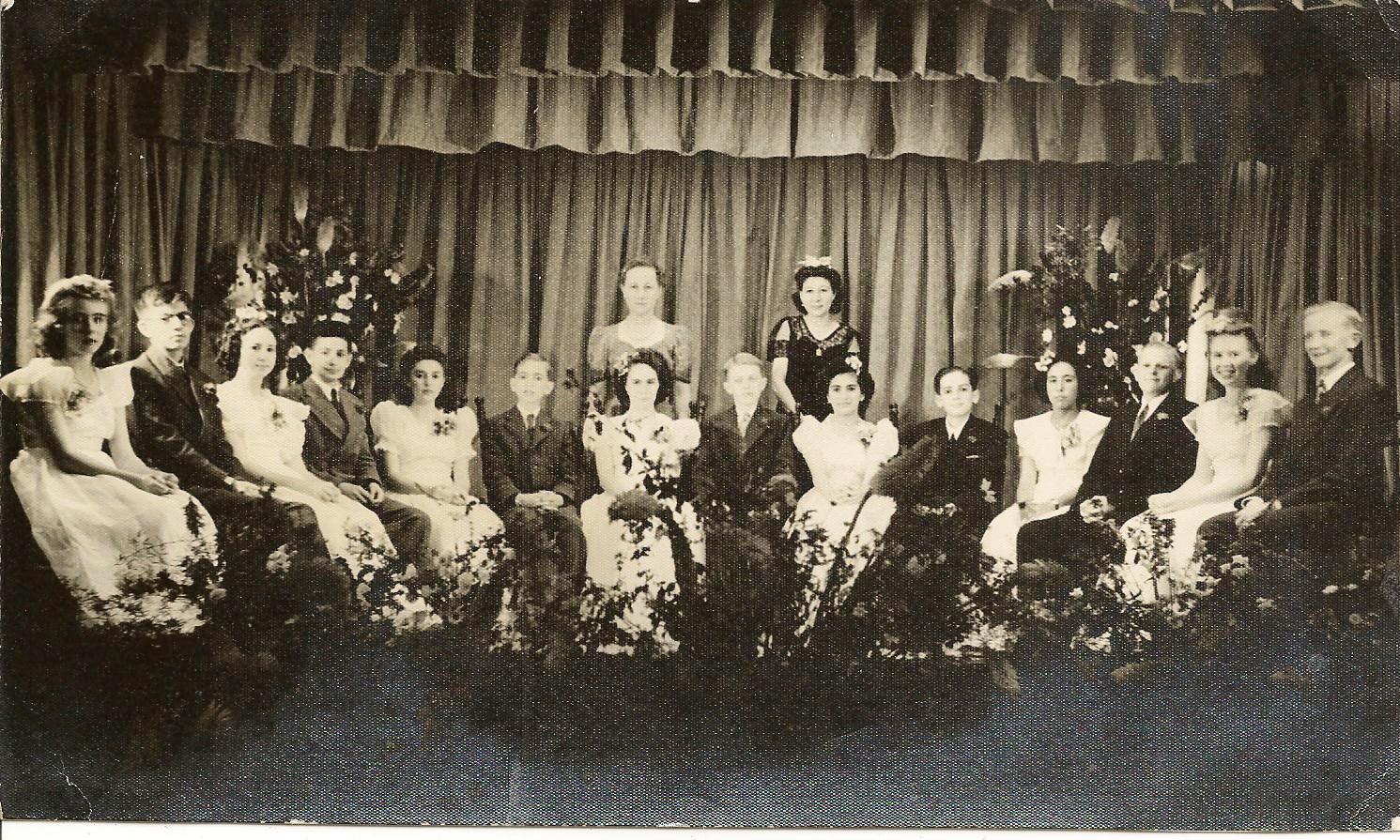
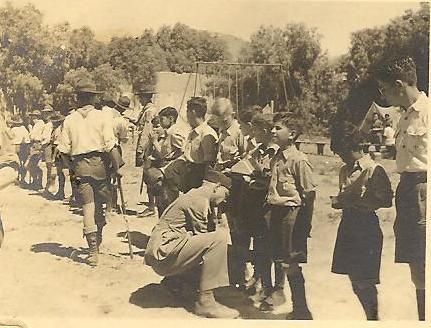

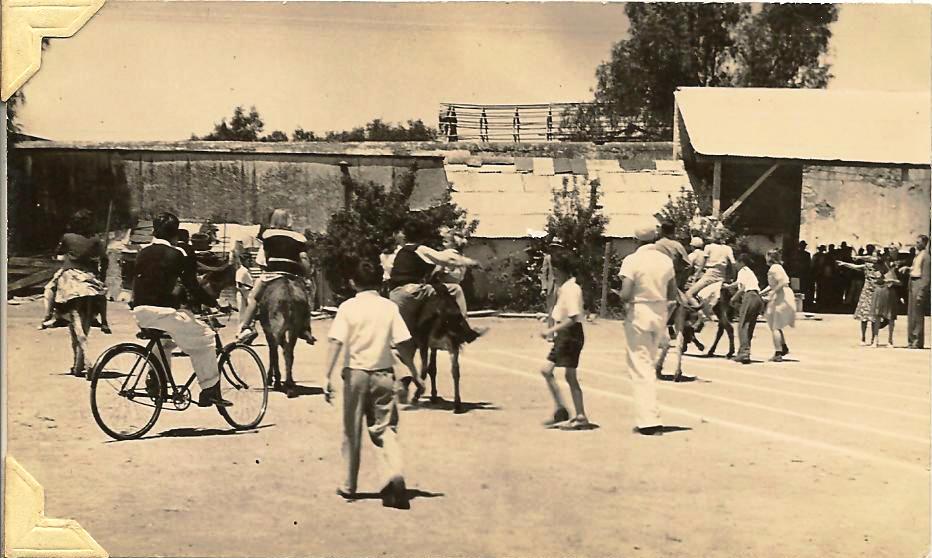
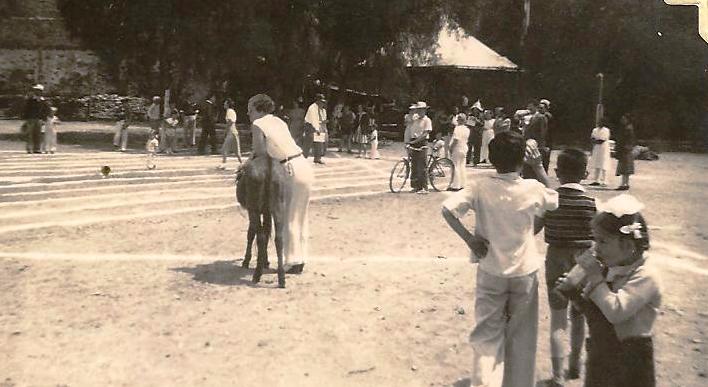
Of Times, Activities, Happiness and Disasters in Pachuca
- before the curtain fell on all that.
By Martin Ough Dealy
Picnics, school, annual holidays, Boy Scouts de Mexico, misadventures, the parents’ part in the war effort, visits to the mill (official and unofficial) all provided, with much else besides, a kaleidoscope of memories of a happy time.
There was a routine and a steady feeling of progression that added to the sense of security in the six years between 1939 and 1946 all spent based in La Casa Nueva. The routine was emphasized by the almost metronome-like regularity of Dad’s working life. He had 11 months of repetitive labour at the mill. His normal routine was to start work at 7 a.m. come home for lunch at about 12 for half an hour and then back to the mill until about 5 in the afternoon when he’d come home for the evening meal which was really the equivalent of an English "high tea" or early dinner.
This daily routine was repeated from Monday to Friday. Saturdays he worked for half the day leaving the afternoon and Sunday free – at least theoretically. In his early days at Loreto as a foreman he was on duty every other Sunday and that meant that he’d disappear into the mill for about an hour on the duty morning and do a round checking that all was well in his particular area of responsibility. More often than not the routines were interrupted by some crisis or another that resulted either in his spending more time during the week at work, or a curtailment of his weekend free time.
The rhythm of our immediate life was governed by Dad’s routine and nothing could interfere with it. He gave his job top priority and that took precedence over family affairs except when there was a serious problem affecting a member of the family or friends or he was on his annual holiday. What we did with free time really depended to a significant extent on whether Dad was free. Often, especially in the early days at Loreto, I recall the disappointment of plans for weekend activities being ruined or postponed by some sudden crisis that needed his attention.
The RDM British American School
La Cia Real del Monte y Pachuca ( RDM for short) together with other mining companies in Pachuca had set up in the early 1900’s a school for the children of employees, especially those of expatriate families. So the English/American School of Pachuca had been going strong for a relatively long time before I was sent there. It had been long established in one half of an hacienda called La Luz in the south part of the town of Pachuca. This hacienda must have been at least a century old and had originally been owned by a mining company and had at one time used for mining operations of some sort. At the time I knew it La Luz had been converted for use as a school and as a centre for various community activities.
The whole place occupied an area of about a hectare and was surrounded by the usual high thick stonewalls with access through large double gates of solid wood. The gates with a height of some 15 to 20 feet were painted in the company colour green and large enough to allow big trucks to go through. They opened out in two halves. Normally the gates were kept shut and access for pedestrians was provided through a small door cut into one of the gate halves. There were two gates one on the north wall to the school and the other on the south side to the larger portion of the hacienda where there was a large open space used mainly by the expatriate community for all sorts of activities, including sports like base ball and American style football, children’s parties with hide and seek and tag, scout parades, fund raising events for the war effort and community celebrations. Against the high walls of this part there were various buildings and facilities, some as old as the wall itself like a huge and deep water tank used by the original mining company that built the place but converted to a swimming pool, a church and a community hall cum gymnasium. The latter was the newest and apart from the pool, often the most used facility.
There was an internal high stonewall separating the school grounds from the rest of the hacienda. The part occupied by the school perhaps took up a quarter of the total area. The classrooms were all on the ground floor and most were along the line of the main outer stone wall of the hacienda. I cannot remember the layout exactly but have a distinct memory of some of the classrooms being dark and dingy and these were those built next to the outer wall, whilst a few others were lighter and must have had a frontage to the inner patio of the hacienda. The school library was on of the darker dingier rooms, but once I had discovered what it had to offer in the way of books and magazines I found it a favourite place, especially during the breaks between classes when the alternative was the playground where school bullies (and there were several) would make life a misery for the younger and smaller children.
The school was run along mainly American lines taking children from first to eighth grade. The American influence stemmed mainly from the fact that at the school was really set up by the RDM company, American owned at that time and by far the largest and most influential of the mining companies still operating in the Pachuca - Real del Monte mining area. Most of the children were inevitably from American families who made up the largest foreign community in the town. But perhaps a fifth were from English expatriate community and another significant proportion of children from Mexican parents employed by the local mining companies.
The school was really provided for children of parents of managerial status in the mining companies. I cannot recall any child there who would have come from parents in the ranks of "workers". The latter were drawn from the local population. Most of the mill workers were descendants of the original Indian population from pre Hispanic days as well as people of mixed blood resulting from the union of Indian and Spanish cultures over the centuries…the mix varying from mainly Indian to mainly Spanish. With its very long history of mining many of the workers in Pachuca were third fourth and even more generations with mining backgrounds, some perhaps able to claim connections back to pre Hispanic times when the Aztecs were recovering gold and silver from the area





I have tried hard to remember who taught me at that school. Two names are firmly fixed. One was Miss Waters and the other was Miss Zea. Miss Waters was the daughter of "old man Waters" who was the local Methodist preacher of Cornish descent who had been in Mexico almost all his life and whose family had been long established there. He was a pillar of the English community. Mary Watres was a small woman with, to my young mind, a formidable presence. In my early days there I looked on her with awe and contact with her was the result of some misbehaviour on my part leading me to her door. She had a genius for making one feel small and I dreaded her beady eye. Later, when I got into the fifth and sixth grades where the contact was in the class room I learnt to regard her with less dread and to respect her teaching.
Miss Zea was a young Mexican lady and was one of my first teachers. I am sure she played a large part in my learning to read, building on what Mum taught me at home. Miss Zea also played the piano and would lead and teach her small class the songs and rhymes used for primary schooling. I do not know what it was about Miss Zea, but I enjoyed her teaching and regretted the day she left the school to get married. She was not at the shool for very long…perhaps for only a year, yet there was something about her that has left an indelible memory.
Miss Zea’s successor was a much harder American lady who was probably a much more effective teacher, but the experience was not nearly as pleasant as the regime of Miss Zea. Even so she taught me arithmetic, how to multiply and divide and she introduced me to the library. It is curious that even in this remote school in a strange place I was introduced to amongst many others, the books of the Amazons and Swallows and for the first time to a world of water, boats, imaginative games in a country foreign to everything I knew at the time.
Contrasted with this was the vivid and horrid memory of seeing copies of the National Geographic magazine in the library portraying in graphic detail the savage religious rites of the Mexican Aztecs. Most vile were the pictures of young sacrificial victims lying on the sacrificial stone a the top of the Sun Pyramid in Technohitlan with their chests cut open and their still beating hearts being offered to one of the many blood thirsty Indian gods. Oh how those pictures terrified me and my skin still crawls just to recollect them! They were reminders of the ever present cruelty and mindless savagery latent in the local people yet still manifesting itself from time to time even in the mid twentieth century.
The weekly routine was well set during school semesters. Dad would have had his breakfast and left for work by the time Charmian and I were aroused…I suppose some time after 7 in the morning. Breakfast was quickly followed by the scrabble to find school satchels and homework and then the run passed the houses next door along the short, narrow concrete platform drive in front of the houses and through the gate to the road outside. There we waited for the taxi that took us to school.
The taxi was hired by 3 or 4 families in the immediate area. The taxi was usually the same one…. A beaten up old pre-war Plymouth driven by a man who seemed to have endless patience despite his somewhat dishevelled, villainous appearance. He always seemed to wear a Fedora hat. I do not remember him ever outside his taxi…he somehow managed to avoid getting out of the taxi during all the times he drove us to and from the school. He had the trick of stretching his arm through his window to reach behind for the door handle of to open the rear door. This was possible because the Plymouth was of the vintage where the rear doors hinged at the side nearest the back of the car….dangerous if the door opened when the car was in motion but making access for the rear passengers much easier.
By the time the taxi arrived at our green gate it had already at least two young passengers - the children of a family further up the hill above us. At our place Charmian and I would be picked up along with Tom and Ann Harrington. Tom and Ann were the children of our next door neighbours an American family. Ann was a year older than I and always seemed to me to be a remote and brainy person. Tom was younger than me by a year and a great play mate. Ed Harrington the father was a big man and stocky in build. He was involved in the diamond drilling operations used to explore and survey the area looking for new ore bodies to satisfy the insatiable appetite of the mills.
Next door to the Harringtons in the other half of the semi detached pair of houses lived the Neelons. I never really knew them…they were an older couple with two sons who were at that time in their teens and at school somewhere in the States.
After picking us up the taxi would then back off the short unsealed drive onto the road and then turned to go forward down the steep hill below the houses. This part of the drive to school seemed at times to be fraught. The road was steep, narrow and had a blind corner and the driver never could trust his brakes…probably with good reason. So he would leave the car in first gear to slow its passage and honk his horn as he approached the blind corner, but that never seemed to make a difference to the drivers going in the opposite direction, especially if they were driving one of the old RDM Mack trucks. These seemed enormous and very intimidating. These Mack trucks were of the old fashioned chain driven variety and most had been made in the 1920’s, painted in the dark green used by RDM, slow and ponderous with open cabs. These behemoths would stop for no one and if met on this road down to Loreto gate it was the taxi that had to stop and back up the hill to make way.
Once down the hill the taxi stopped to pick up Gordon Tucker and one or two other children who lived in flats inside the Loreto Mill complex. Gordon was older than me, and like Uncle Syd had been crippled by polio. Gordon was a great playmate and at thremained a friend, until his death in far away Vancouver.in 2011.
With its load of 8 or so children the driver would then take us through the town to drop us off at the La Luz school gate generally just in time for the start of school. The return home form school was the reverse process and the adventurous part was the last climb up the hill passed the Loreto Mill gate. Here the driver would put his foot down and rush his taxi at the slope ahead, hoping to have enough momentum to carry him round the blind corner to the place where our "drive" joined the road where he could drop us off. This proceeding always seemed to be a gamble….would he have enough speed to make it, would he meet another vehicle coming down the hill and then have to retreat for another go?, would the brakes hold? Could he avoid any of the many miners and others walking down the hill after a hard day under ground and not too careful about keeping out of the way of desperate taxis? There was also the possibility of meeting either alone or in groups, donkeys driven by more often than not an unsympathetic peon who cared nothing for the welfare or safety of his charges. These poor animals were a common feature of Pachuca in those days and almost always seemingly overburdened invariably thin, plagued by flies drawn to the open sores and wounds, yet with sad patient faces.
The taxi driver somehow managed most of the time to deliver us home without incident. May be there was good reason for his faith in the statue of La Virgen and the image of Jesus on the Cross that he kept on the dash board.
After the return form school we were left to our own devices until the evening meal. We weren’t allowed outside the compound of the three houses, but nevertheless had plenty to do and opportunities to get into scrapes and mischief. There was a swing between our house and next door and the concrete drive provided a marvellous surface for using wheeled toys and skating.

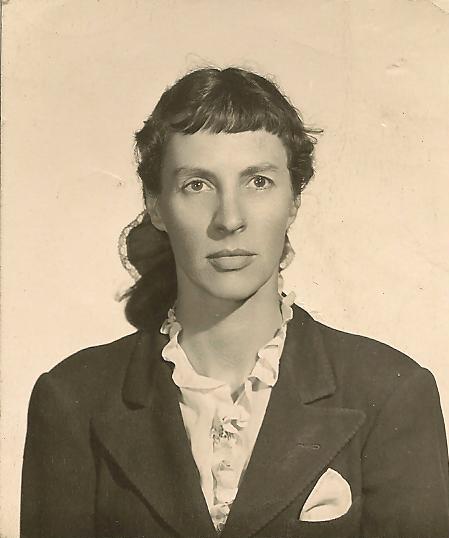

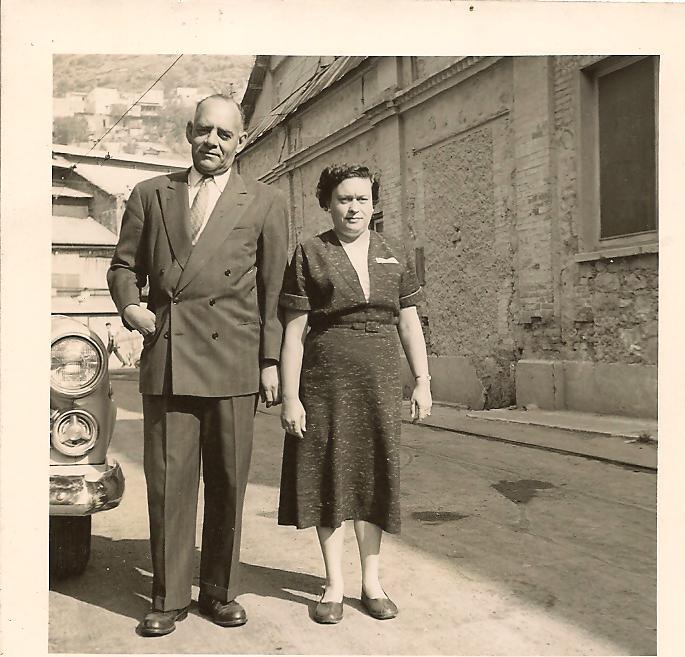
Ours Was a Closed Community Based on an Extended Family
Of course I was not of an age where I understood any of this, but even to my young and inexperienced and unformed mind it was clear that there was a barrier the English, Americans, Germans and other foreigners living in this small isolated artificial culture lived an almost separate life from the rest of the locals. We simply were not brought into contact with "Los Demas" except under some sort of adult supervision. We lived in a kind of cocoon of close family, friends of the family and with occasionall access to the wider expatriate community.
The Ough family was in those days close-knit and consisted of several circles. The inner most circle was of course, Mum, Dad and Charmian. Then there was Granny (Annie) Ough and Uncle Syd, Dad’s eldest and crippled brother. Granny Ough and Uncle Syd lived close by first at the house in Progresso and then later from about 1942 onwards in a flat situated within the walls of Loreto Mill itself, just a five minute walk down the hill from La Casa Nueva.
The next circle in the family was the Rule family. Aunt Amy (Dad’s sister) married Cecil Rule the youngest son of the family in 1930 and they first lived in Chavaria, the hacienda owned by the Rule family just outside Pachuca on the road to Tulancingo, not far from the village of Pachuquilla.
The Rules were our rich relatives but had fallen on hard times by the time I really got to know them. The hacienda Chavaria had been taken over by about 1939 by the Government and broken up and distributed to the local people. Cecil’s father spent what remained of his life trying to salvage something from the wreckage of his fortune but died in the early years of the war. Uncle Cecil was forced to take a job at Maestranza, where RDM had a large machine shop and transport support depot. By the time I was old enough to remember them he and Aunt Amy lived in a small company house in this part of Pachuca with their two children - cousins Audrey and Noel. Maestranza was another walled in complex but on the south side of the town on the road out to Mexico City. When we went there to visit it was always by car; it being too far to walk and so the visits were not particularly frequent.
Cecil’s brother Gordon was the eldest of the family and had inherited I suppose what was left of the huge fortune built up by his great grandfather the Cornishman "Capitan Rule" who lived some three generations earlier. At the time I remember Uncle Gordon in the early 1940’s he lived with his mother Granny Rule in a small house in a street not far from the English/American School at La Luz. He and Granny Rule were a bit of a mystery for me…I have few recollections of either of them. Gordon smoked a lot, played a lot of bridge, but was a bit of a recluse. He did not seem to have a job, and I suppose he lived on his inheritance that by that time could not have been much. The fortune left by El Capitan Rule had gradually been whittled down and dissipated by mismanagement, ill luck and the depredations of the legalized theft sanctioned by the Mexican Government especially during the 1930’s when anything owned by foreigners was taken over with little or no compensation. Typical of those times was the nationalization of the Aguila Oil company previously set up by Pearson, who later became the famous Lord Cowdrey.
Granny Rule was, like her eldest son, reclusive and closed. She was a small, wizened lady with grey hair done one up in a bun at the nape of her neck. She always seemed to wear dark clothes, long dresses, long sleeved and in retrospect very Victorian. Her features were narrow and her smile, on the few occasions she deigned to show it was pinched and somehow disapproving. She rarely had anything to say to visitors and nothing to youngsters like Charmian and I….I am sure she believed in the old adage that children should be seen and not heard and so she remained for me remote and inaccessible. I rarely saw her and when I did it would be on formal visits for tea where we had to be on our best behaviour. As part of doing her "duty"s Mum would make the rounds of relatives and friends part of her family "rounds" Charmian and I would be taken along.
Granny Ough, Dad’s Mum was a complete contrast to Granny Rule. I saw a lot of Granny Ough in those days….On Saturdays and Sundays, the family routine would generally involve a picnic, and /or tennis at the Pachuca Tennis Club, or visits to and from family and friends. Almost invariably we would go to Granny Ough’s for tea on either the Saturday or the Sunday These sessions were regular family gatherings especially in the days when she and Uncle Syd lived in Loreto. The routine was fairly predicatable….we’d arrive at the set hour and sit down for the meal. The adults were set round the main dining room table whilst the younger generation were placed at a separate smaller one. Tea was served out of Gran’silver tea pot and the ritual was very English. With tea would come traditional English style sandwiches with fillings like beetroot, cucumber, sardines. But often there would also be something Mexican on offer. Tamales bought on for the occasion from a local supplier were a favourite. These would be brought in from the kitchen in the large tin can provided by the supplier. Each tamal was wrapped in leaves of corn packed steaming hot into the can and the lot covered by a white cloth to keep them warm. The choice was either "verde" or "roja" and they were really a special treat, hand made in a local shop they would often be accompanied by salad and "guacamole" ( the flesh of avocado pears mashed with onions, chile cilantro and garlic.
Granny Ough had a heart of gold, a lovely smile and the gentlest eyes of anyone I have ever known. She was often my refuge and especially when I had received retribution for my many misdemeanours. Granny would take me aside give me a comforting hug and as often as not find me something sweet too eat. She always smiled, and the smile was of the kind that lights up the whole face, genuine, and rare for all that. Things I will always remember about Granny Ough were her scent of lavender (she kept bags of the dried leaves of this very English plant in her linen and clothes drawers), her always offering "a nice cup of tea" and her unfailing good nature. I never knew her to say a cross word, yet she had had a life to try the patience of job and the courage of Rachel.
Uncle Gordon died in 1942 and his going my first experience of death in a family. He is buried in the Cornish Cemetary in the town of Real del Monte only 6 miles from Pachuca but at the higher altitude of over 10000 feet.. He lies near Grandpa'Oughs grave.
Sadly there were many barriers and conventions within the community of expatriates that separated the English from the Americans and other nationalities of the foreign colony in Pachuca. This I find hard to explain from the perspective and within the context of the time of writing some sixty years on. Many of the English expatriates kept themselves separate from the Americans and the rest following their own social activities and maintaining customs brought over from "home". Some of the reasons were historical and born of pride or arrogance…many of the English community were people who were second or third or even more generations in the country…descendants of the original Cornish and others who came to Mexico shortly after the War of Independence in the 1820’s. Dad for example was second generation whilst I was third. Grandpa Ough had first worked in Mexico in the early 1900’s and consequently both Dad and I could claim Mexican and English citizenship. But it was the English connection and culture that was given the priority. In general the families of English connection and descent regarded the Americans in the community as newcomers….. the yanks were interlopers who really first appeared on the scene only in the early 1900’s when the RDM was taken over by the American Cynamid mining company (Check this name).
These divisions within the foreign colony seemed to me to be sharpest during the early days of Dad’s employment at RDM that coincided with the early days of World War II when England was fighting virtually on her own. Later, I supposed with the progress of the war and American involvement, the things that separated the local English and American communities became less sharp and there were many activities initiated on a joint basis especially when they were aimed at providing support for the war effort. But naturally the rivalries between the various ethnic groups continued and this often manifested itself at school and in the school yard when parental attitudes would be reflected in the behaviour of the offspring.
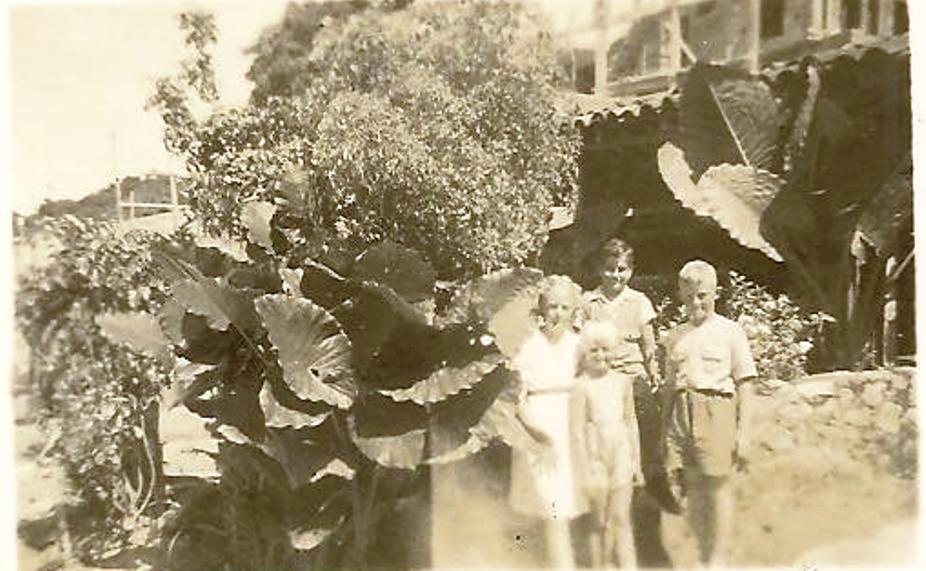


Escapades
The weekends were nearly always something to be looked forward to. The routine gradually changed with the progress of years, but essentially Saturday mornings were spent at home doing something "useful" like being taught French by Mum or doing homework , Saturday afternoons would as often as not be spent at the Pachuca tennis club. Saturday evening was often spent at the local cinema (Iracheta or Pineda or later La Reforma) followed by the purchase of a "take away" meal from Islas the favourite Tienda. Sundays were often reserved for picnics ..Dad was a keen swimmer and had his faourite places…..the established pattern was to go for a swim somewhere …Ajacuba, and Aguas Calientes, were two favourite spots. After the swim we’d drive off into the country side along some dusty road to find a place to picnic. Then, if there was time we’d return to Pachuca for tea at Granny Ough’s.
Both parents were keen tennis players and also very active in the running of the Pachuca Tennis Club. Mumin 1929 won the "Henderson Ladies ChallengeCup" Ladies Singles Competition and was awardedthis handsome silver plate trophy. Dad was awarded a cup for beingbest sportsman of the club and his years of service as President. This trophy was awarded to him in November 1960, Both cups are still in my possesion.
The club in the early 1940's was placed in the old grounds of the Progresso Mill near the Pachuca river. The club was a fairly basic affair…. it had two clay courts and a small wooden hut (painted in the ubiquitous green used by so many of the mining companies) as a club house. The courts were surrounded by a high wire fence behind which were various trees of the local Pirul variety ( a kind of gum tree with a very distinctive attractive scent and feathery leaves) . The trees and bushes somehow managed to survive in the dry high altitude climate of this dusty locality and disguised the wrecked remains of the old mill.
The mill remains were mainly piles of rubble hard rock and bricks amidst the hard concrete and rock foundations for the long gone machinery. Still standing was an old chimney of about 40 feet in height…it was what was left of the boiler house for the mill machinery and was a place of mystery and dreadful memory for me.
Left to my own devices whilst tennis was in progress one Saturday afternoon I had crawled with another boy into the tunnel leading to the bottom of the chimney. The entrance to this small tunnel was behind a small pirrul tree and in a mound of earth and old furnace bricks. Squeezing into the narrow entrance I remember seeing a glimmer of light at the end of the tunnel where it joined the chimney ….. light which filtered down from the top. It was this light and I suppose insatiable childish curiosity that drew the pair of us along crawling on our stomachs along the ever narrowing tunnel. But when we got to the end of the 30 feet or so, our over active imaginations worked on by the semi gloom, the confined space, the smells of dead things and excrement created a sudden sense of fear and panic. Neither of us could turn inside the tunnel and my companion was unable to crawl backwards, so the stark choice was either to stop and hope that someone would find us or carry on further into the base of the chimney and hope to turn round there. That was my first real encounter with fear and panic and I must say that I felt like a rat in a trap, paralysed and stuck in the tunnel I was really scared. Ahead I remember just being able to see a pile of rubble in the base of the chimney and the reality that there was not much chance of finding enough room to turn and go back let alone room to allow my companion to come forward and do the same….we really were stuck!
Fortunately Mum had by that time sensed the something was wrong….there wasn’t the usual noise of children racketing around in the club house and she raised the alarm to set up a general search of the area.
The state of alarm of both sets of parents was heightened by the memory of the abduction and murder some years previously of another child in the same area. I was later told, the boy victim’s body had been found in the very tunnel that I had been trapped in……. of course I did not know that at the time and anyway I was too terrified by my own precarious situation to have cared. Anyhow eventually someone heard the bellows of two very frightened boys coming from the chimney area and so established where we were. The problem then was to get us out. Digging was out of the question and eventually the solution was to get one of the smaller adults to crawl into the tunnel and drag us out feet first!
Neither of us received much sympathy from our parents I can tell you! But this time there was no physical chastisement ……. I guess Dad reckoned that the experience was a sharp enough lesson and that I was unlikely ever to want to repeat the escapade.
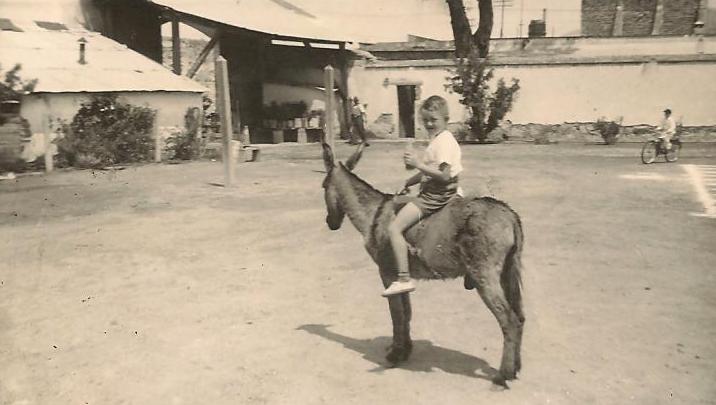
Picnics were another Delight.
Picnics were often adventurous affairs and involved several families and friends. After preparation of picnic food and getting together the paraphernalia required, the cars ( more often than not two or more vehicles were needed to carry everyone) we’d set off in convoy. Our car, initially was a 1934 Ford sedan with and old fashioned Box for a "trunk, but later replaced by the1939 Chevrolet Dad bought just after he joined RDM in 1940 (?). That car reminded me of a shark with its great grinning radiator grill. Most often the Tuckers older more sedate Chevrolet would be the other vehicle in the convoy, but occasionally this would be replaced or added to by the Buick owned by Uncle Cecil. The destination varied, sometimes we’d go first to a swimming venue like Ajacuba some hours away along a long and dusty road in the Valley of Mexico, other times we’d head a favourite picnic spot like Las Ventanas the place name for a strange volcanic rock formation pierced with holes near its summit (hence the name which means "the Windows") in the forested national park in the mountains behind Pachuca and Real del Monte near the old village and mining town of El Chico. Other destinations included places further a-field where the attraction would be a town like Tulancingo, famous for its "leche Quemada ( a caramelised sweet condensed goats milk that used to be sold in circular wooden boxes) or Tula renowned for its ancient Indian relicts, or even the famous pyramids of the sun and the moon at Teotihuacan.
These picnics often involved driving over long distances, starting off over the reasonably well made roads out of Pachuca but then soon diverting off onto unmade roads with rutted dusty and rock strewn surfaces. The roading system was primitive in those days and most of the system consisted of no more than just twin wheel tracks It was just as well that the cars we had were strong well built with sturdy springs and steering, because the poor roads placed huge demands on our vehicles. Even so it was a common experience to have at least a flat tyre or to get stuck in some impossible piece of road.
Once the main event of the trip had been accomplished….a swim, or looking at ancient ruins or looking around the locality, we’d set off for a picnic spot for a meal. Many times the place would simply be randomly selected as we drove along….the shade of a large and inviting grove of trees, or a spot on the road that overlooked one of the many magnificent views of valleys and mountains. I am sure that we tried to avoid stopping in populated places because we often immediately became the targets of locals who liked to gather in groups and stare at us. Sometimes they’d ask for money or a hand out of some sort. So generally our favourite picnic places would be isolated spots and as far from the madding crowd as possible. Even so people would appear as if out of no where and we were not often left to picnic in peace.
WORK IN PROGRESS
Copyright of all parts of this site is owned by M.& M.M. Ough Dealy
This page last modified on Tuesday, 27 July, 2021